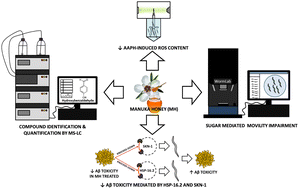Amyloid β-but not Tau-induced neurotoxicity is suppressed by Manuka honey via HSP-16.2 and SKN-1/Nrf2 pathways in an in vivo model of Alzheimer's disease
Abstract
Alzheimer's is a chronic degenerative disease of the central nervous system considered the leading cause of dementia in the world. It is characterized by two etiopathological events related to oxidative stress: the aggregation of β-amyloid peptide and the formation of neurofibrillary tangles of hyperphosphorylated Tau protein in the brain. The incidence of this disease increases with age and has been associated with inadequate lifestyles. Some natural compounds have been shown to improve the hallmarks of the disease. However, despite its potential, there is no scientific evidence about Manuka honey (MH) in this regard. In the present work we evaluated the effect of MH on the toxicity induced by Aβ aggregation and Tau in a Caenorhabditis elegans model. Our results demonstrated that MH was able to improve indicators of oxidative stress and delayed Aβ-induced paralysis in the AD model CL4176 through HSP-16.2 and SKN-1/NRF2 pathways. Nevertheless, its sugar content impaired the indicators of locomotion (an indicator of tau neurotoxicity) in both the transgenic strain BR5706 and in the wild-type N2 worms.



 Please wait while we load your content...
Please wait while we load your content...